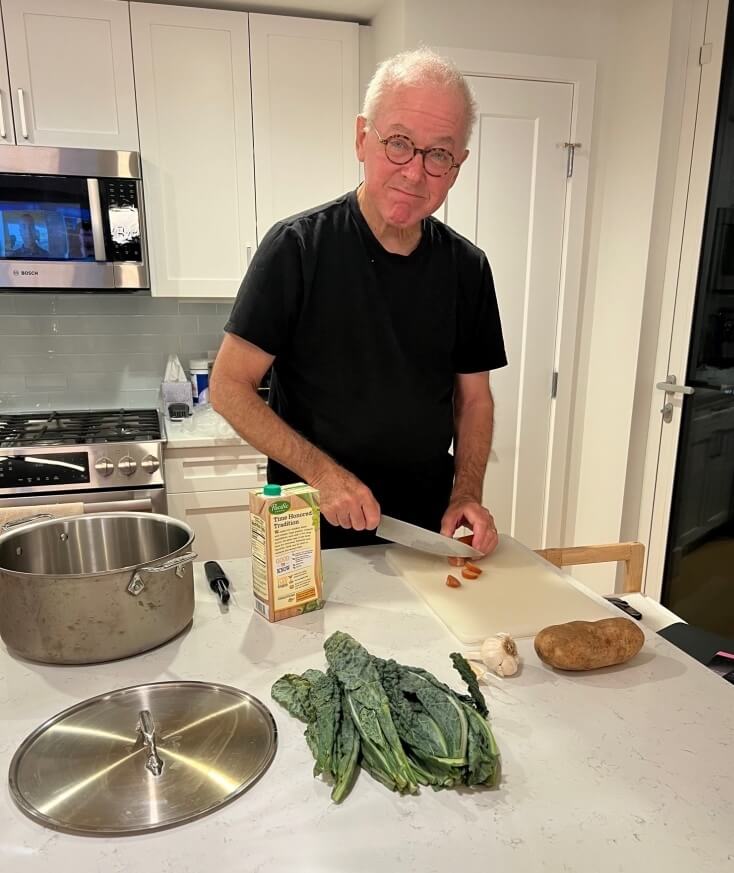David Trueblood’s long career in journalism was shaped by new technology, including the rise of digital photography and the impact of online media. So, upon learning in early 2023 that he would need a stem cell transplant due to myelodysplastic syndrome (MDS), a rare blood disorder impacting his bone marrow, Trueblood appreciated the role innovation played in making the process a smoother one.
Just a few years before, all patients receiving transplants required lengthy hospital stays to deal with side effects as their stem cells began to grow into a new immune system. Now, due to improvements in understanding and technology around the procedure, a growing number of patients treated in the Adult Stem Cell Transplant Program at Dana-Farber Brigham Cancer Center can get their transplants as outpatients with daily in-person monitoring by their clinical team.
Those who qualify as outpatients must stay close by Dana-Farber Brigham’s Longwood campus during their initial weeks of recovery. For many, that means finding temporary housing. Trueblood, however, lives just across the Charles River in Cambridge.
“Every morning I went into Dana-Farber Brigham, and every night I went home to my husband and my dog,” says Trueblood. “That meant the world to me, especially because I never imagined it would be an option when I first learned I might need a stem cell transplant.”

Finding a ‘magical place’
Before his MDS diagnosis, Trueblood had never heard of the disease. It was in 2017, after transitioning from a managing editor role at a Boston-area newspaper chain to public relations positions at various local nonprofits, that his world changed forever at an unlikely locale: the gym.
“My husband and I were getting ready for a workout one morning, and I just passed out – fell face-first on the mat right in front of the trainer,” Trueblood recalls. “The trainer strapped her smartwatch on my wrist to check my heart rate, which was consistent with somebody in cardiac arrest. So, she picked me up, ran me out to her car, and drove me to the hospital.”
A series of tests led to Trueblood’s MDS diagnosis, and he started a chemotherapy protocol to keep the disease in check. Initially treated at a Cambridge hospital, he was referred to Dana-Farber Brigham because of its expertise in treating blood disorders like MDS. There he came under the care of oncologist Jacqueline Garcia, MD, who in addition to her clinical duties, is part of a laboratory team seeking new clinical options.
And as the years passed, Trueblood went through several standard of care regimens as well as a novel clinical trial that was insufficient to improve his symptoms or his anemia (where the body makes too few red blood cells). The treatments often sapped his strength — but never his hope.
“When one drug lost its effectiveness, Dr. Garcia always had another one for me to try,” recalls Trueblood. “Dana-Farber Brigham felt like a magical place where everybody I met, from the parking attendants to my clinical team, were not only incredibly good at what they did, but also deeply kind.”
In time, Trueblood adapted to life with MDS. Although fatigue prompted an early retirement, he was inspired to train as a chef and settled into a comfortable routine of cooking for and spending time with family and friends. He and his husband sold their large house and moved into a condominium that was easier for Trueblood to navigate. And although much of his treatment coincided with the COVID-19 pandemic and visitor restrictions, the expert care and empathy he received made coming to treatment by himself much easier to take.

Still cooking
Then, in January 2023, came another challenge. The next most effective agent Garcia had found to treat Trueblood’s MDS, a drug called Inqovi, was no longer working effectively after 17 months of treatment. Garcia decided it was time to introduce her patient to the newest member of his care team: Corey Cutler, MD, MPH.
“It was clear that David had hit his maximal response on Inqovi, and was starting to become more anemic,” explains Cutler, director of the Adult Stem Cell Transplant Program at Dana-Farber Brigham. “Dr. Garcia had nothing else great to offer him at that time, so we moved on to a transplant.”
At the time of his 2017 diagnosis, Trueblood was told that if he ever needed a stem cell transplant, the procedure would necessitate a long hospital stay. Now, to his delight, he learned that he could have an allogeneic (or donor-provided) transplant as an outpatient and return home the same day.
That day was Jan. 26, 2023. With the remaining cancer cells in his body knocked out by high-dose chemotherapy, Trueblood received an infusion of his anonymous donor’s stem cells. He then went home, where his husband tracked his vital signs and cognitive function and reported them back to Cutler and nurse practitioner Clare Kearney, NP. Each day, for three weeks, the ritual continued.
While he experienced some side effects, Trueblood’s body reacted well to the transplant. Soon his visits to Dana-Farber Brigham were down to once a week, and then once a month. Nurse practitioner Tricia Severns, NP, joined Trueblood’s care, becoming a key point of contact.

Trueblood still had to stay away from large crowds as his immune system recovered, so he developed a more secluded daily walking route. He also started a new project that merged his two passions — taking his mother’s old recipes dating from the 1950s and putting together a cookbook to share with loved ones.
Now that Trueblood has marked eight months post-transplant, Cutler says his long-term prognosis remains strong.
“Unlike many MDS patients, he was transplanted because his anemia was too difficult to manage, rather than because of high-risk features of his MDS,” says Cutler. “These patients overall have a lower risk of relapse, so his outlook is very good.”
And if a new challenge does emerge, Trueblood is confident his Dana-Farber Brigham team will find the next solution.
“I’m living at this extraordinary moment where health care for critical cases like cancer is being transformed pretty much on a daily basis,” Trueblood says. “Where I am, I know I’m getting an ‘A Team’ that has the richest possible picture of what’s going on.”

I had a stem cell transplant on Aug 26 from AML what a team I have from Dr Koreth, Toni N.P. All the nurses Clare, Corey I am doing good and I can’t thank them enough god bless all
David,
With exception of the diagnosis, our journey through our cancer treatment at Dana-Farber is so similar, right down to three wonderful caregivers you mentioned. Dana-Farber and staff are such a blessing. .So glad to hear you are doing well, we are both in good hands.